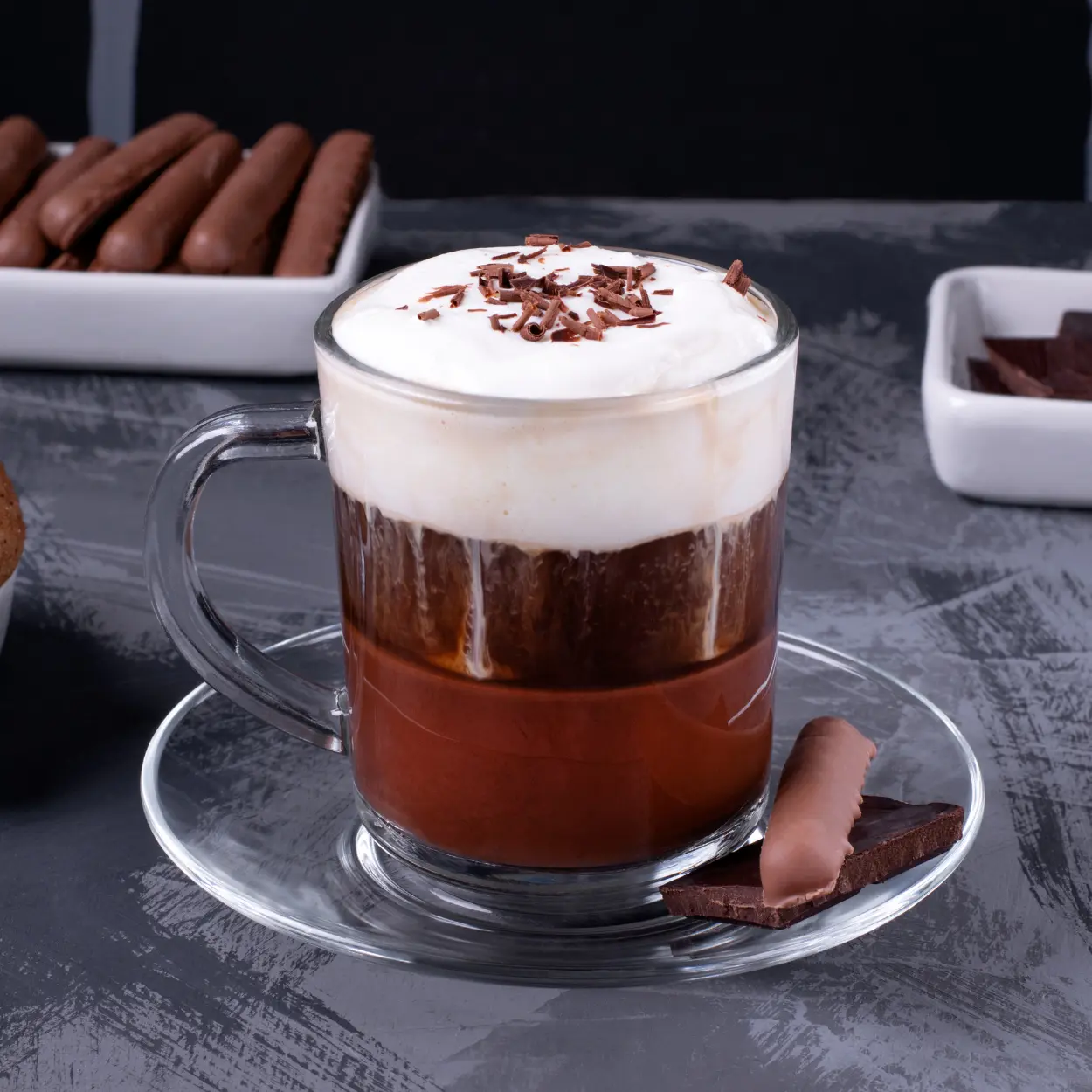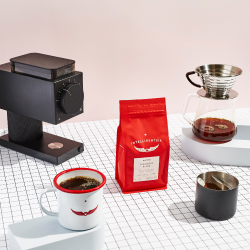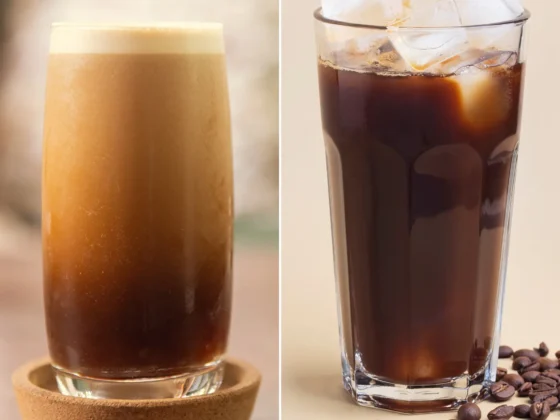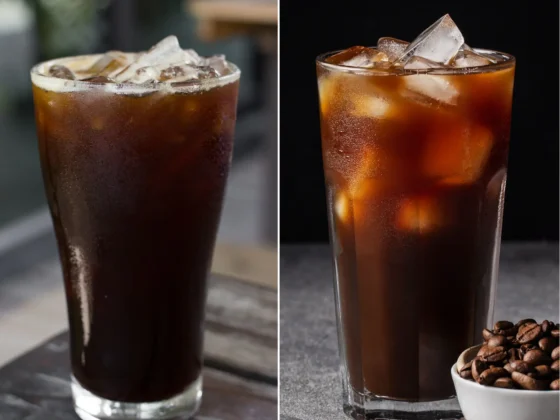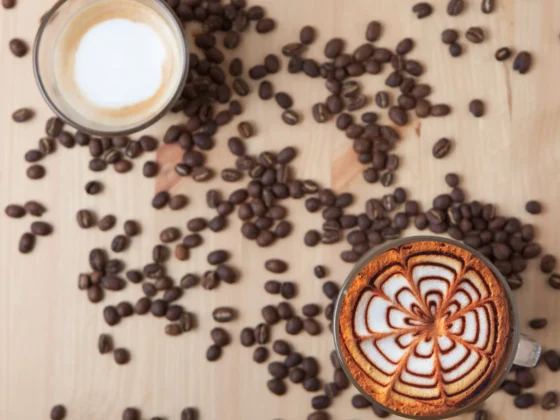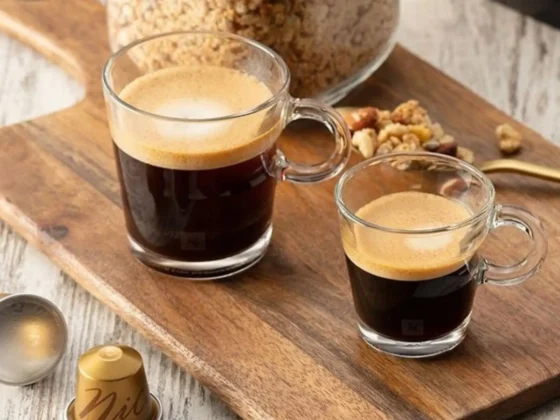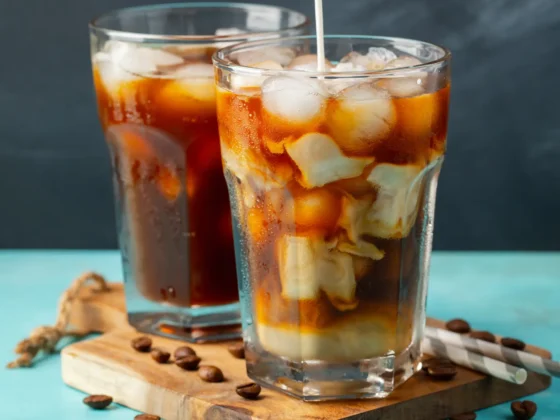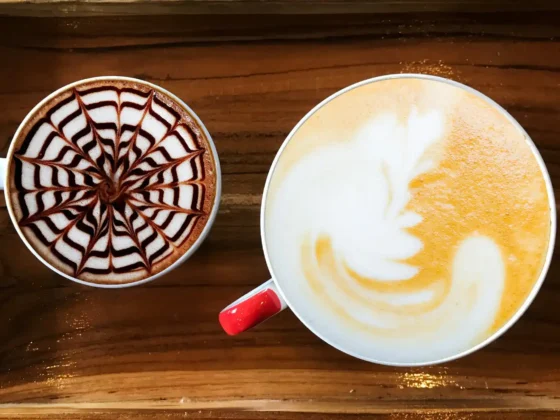Welcome to the enthralling world of Bicerin coffee, a traditional Italian beverage that captivates the senses with its trifecta of espresso, chocolate, and milk. As you prepare to master the Bicerin coffee recipe, it’s worth taking a journey through its rich history. Originating from the cafes of Turin, Italy, Bicerin has grown from a local favorite to a global phenomenon. Its artful layering and complex flavors speak volumes about Italian coffee craftsmanship and make it a significant symbol of both Turin and broader Italian coffee culture. Read on to not only perfect the recipe but also to immerse yourself in the storied past of this fascinating drink.
Bicerin Coffee: Key Takeaways
- Mastering the Bicerin Coffee Recipe: The article provides an in-depth guide on how to craft the perfect cup of Bicerin, a traditional Italian beverage, emphasizing its unique layers and rich flavors.
- Historical Significance: Bicerin isn’t just a drink; it’s a historic treasure. The article dives into its role in Italian history, revealing how it has been a part of significant movements and loved by influential figures over the years.
- Culinary Pairings: Bicerin isn’t meant to be enjoyed in isolation. The article offers insightful tips on how to pair this luxurious beverage with desserts, savory foods, and even wines and spirits to enhance the overall experience.
- Ethical and Sustainable Practices: Beyond its rich flavor, Bicerin stands out for its commitment to ethical sourcing and eco-friendly practices. The article sheds light on how enjoying a cup of Bicerin can also mean supporting responsible coffee culture.
- Cultural Impact: From modern coffee trends to its appearances in pop culture and global appeal, the article reveals how Bicerin has transcended its Italian roots to become a global phenomenon worth experiencing.
History of Bicerin
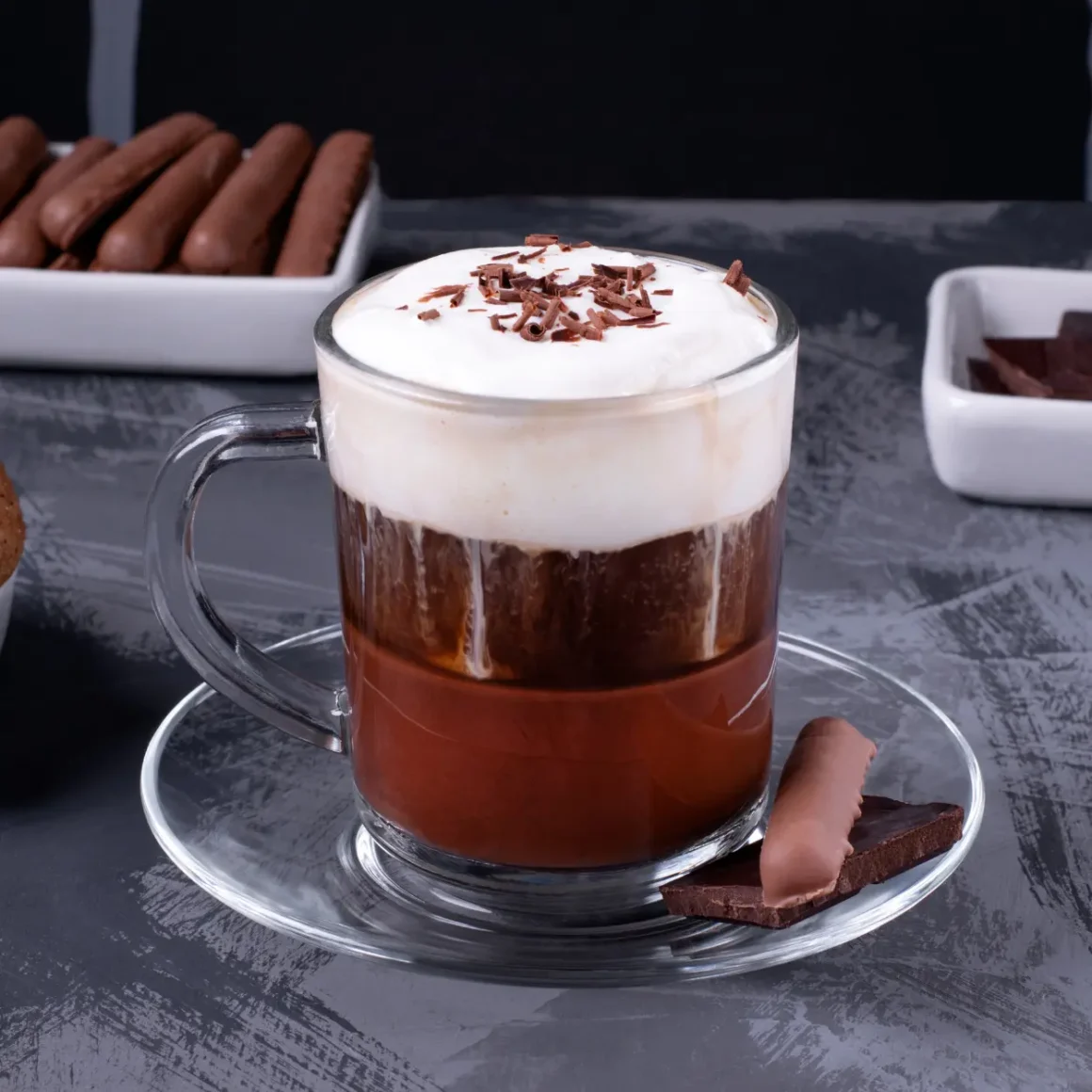
The traditional hot beverage known as Bicerin has deep-rooted origins in Turin, Italy. It’s a layered delight of espresso, drinking chocolate, and milk served in a petite glass. Through centuries, this Torinese marvel has not only dominated local coffee culture but also received international acclaim.
Origin of Bicerin: From Torino to Global Tables
Bicerin emerged in Turin during the 1800s, with its name taken from the Piedmontese dialect, signifying a ‘tiny cup.’ This artistic blend is thought to have been inspired by a 17th-century drink called bavarèisa (“Bavarian”). The difference lies in the layering of its components—espresso, chocolate, and milk—rather than mixing them. (1)
- Earliest Cafés: The drink was first offered to the public in the 18th century at Caffè al Bicerin, situated opposite Santuario della Consolata in Turin. It’s also believed that the drink may have originated at another local establishment, Caffè Fiorio, around 1704.
- Evolution: Initially, the three key elements were served separately. By the 19th century, however, they were unified in a single glass and offered in three different varieties. The version that included all three components became the most popular.
- Global Acclaim: The drink caught the attention of famous figures like Alexandre Dumas in 1852 and subsequently spread its charm beyond Italian borders. (2)
- Fun Fact: The Vicenzi Family Distillery located in Turin also manufactures a liqueur infused with the delightful flavors of chocolate and hazelnut, bearing the same appellation.
The reach of Bicerin coffee has indeed expanded from local Torinese cafés to global tables, making it a subject of both cultural and culinary discourse.
Bicerin’s Significance in Italian Coffee Culture
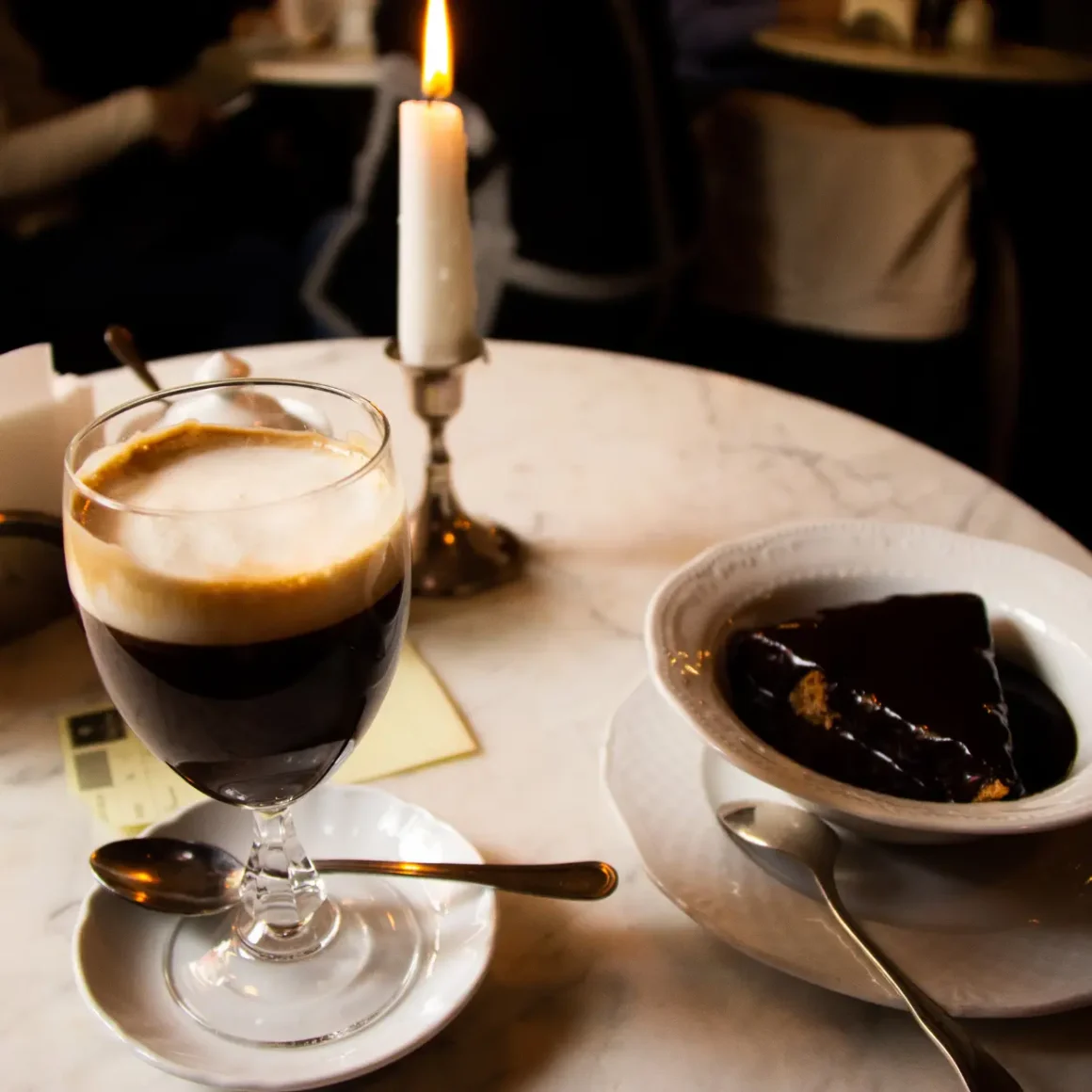
In Italy, where coffee is almost a religion, Bicerin holds a special place, especially in the Piedmont region.
- Symbol of Turin: The beverage has become one of Turin’s icons, celebrated in various local cafés and festivals.
- Historical Links: It is also deeply interwoven with Turin’s history, including being involved in the Risorgimento and the Italian unification through Camillo Benso di Cavour.
- Culinary Evolution: It evolved from bavarèisa, incorporating coffee, chocolate, and milk, which are staple items in Italian coffee culture.
Its layered presentation and complex flavors make Bicerin an exemplar of Italian coffee craftsmanship and cultural heritage.
Famous Cafés and Their Bicerin Tales
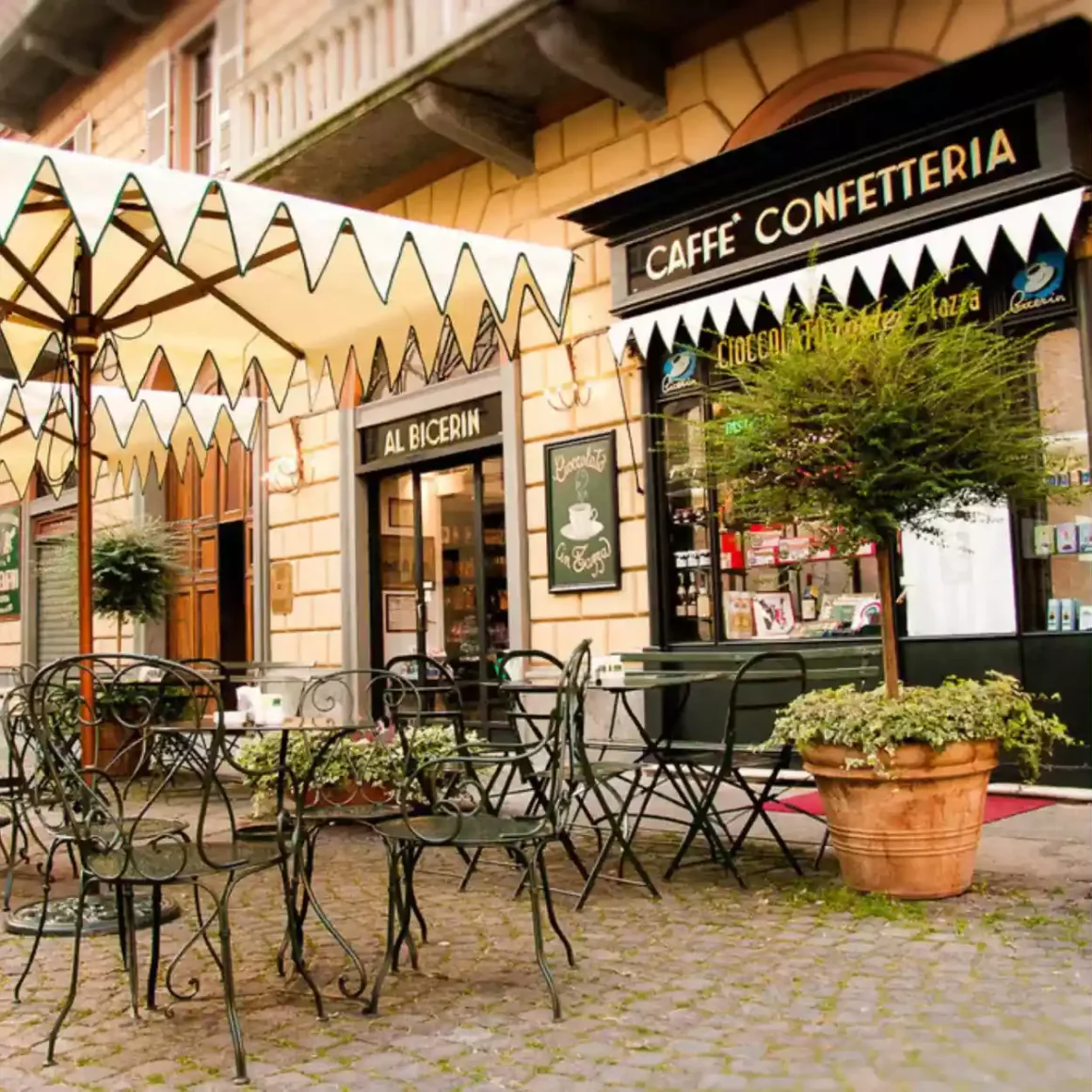
The tale of Bicerin is not complete without mentioning the cafes that have played a role in its prominence.
- Caffè al Bicerin: This café has been serving Bicerin since the 18th century and has a deep historical connection with the city. It was even nominated the “Best Bar in Italy” by Gambero Rosso magazine in 2001.
- Role of Maritè Costa: Under her stewardship, Caffè al Bicerin gained international notoriety. She delved into the rich history of Turinese chocolate and elevated the café to new heights, earning prestigious awards including the 2013 Bogianen Award. (3)
- Legacy: After Maritè Costa’s demise in 2015, the café continues its traditional operations, managed by a family that treasures the art of Bicerin.
Famous cafés like Caffè al Bicerin have not only served this delicious beverage but have also become part of its rich and fascinating history.
How to Make Bicerin Coffee
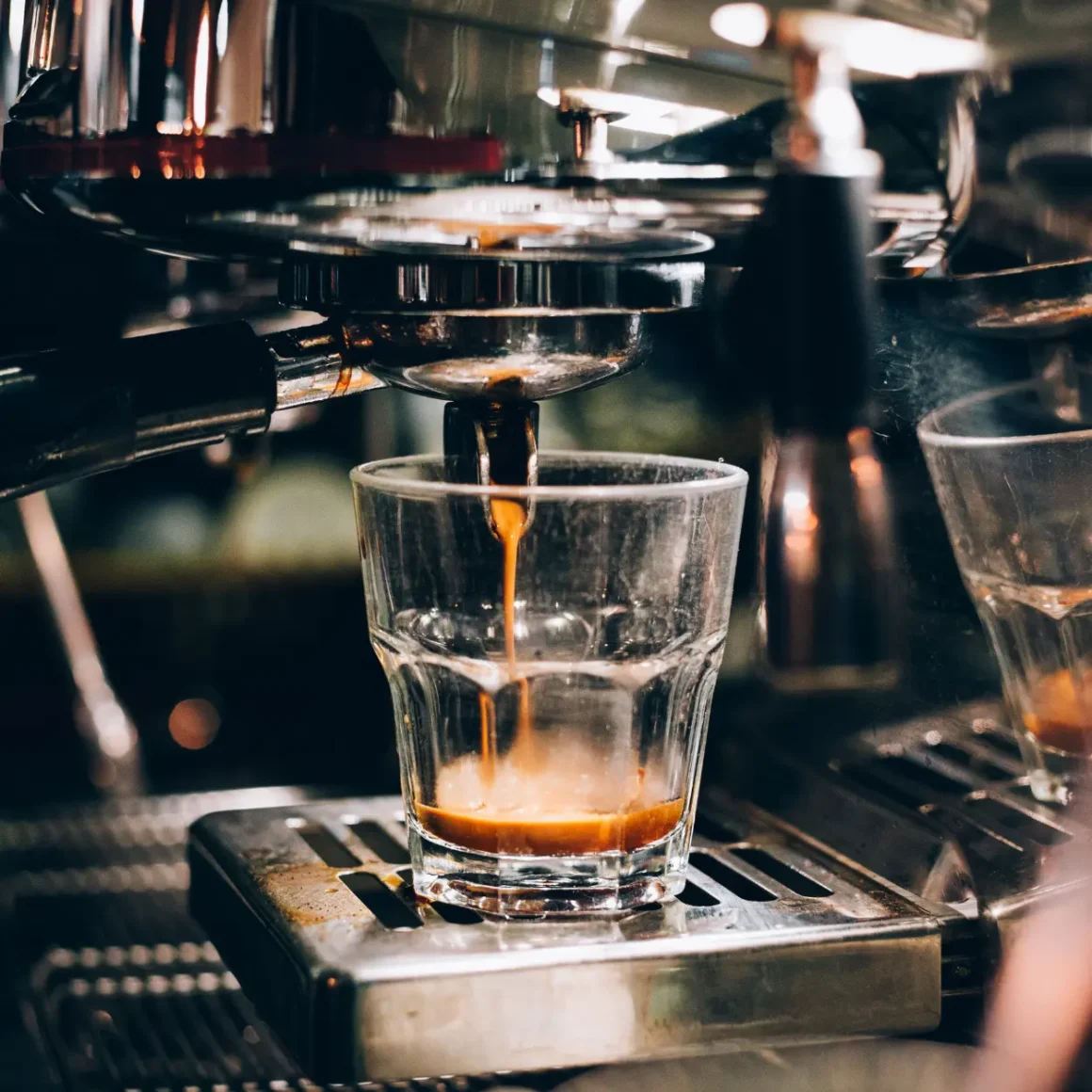
Mastering the art of Bicerin is a venture into the heart of Turin’s coffee culture. This luxurious drink combines robust espresso, rich hot chocolate, and a velvety layer of milk or cream, all presented in a glass to showcase its beautiful layers. In this guide, we’ll break down the bicerin recipe into its essential components, walk you through the process step-by-step, and even reveal some pro tips to avoid common pitfalls.
Ingredients: The Trio that Makes the Magic

To recreate the iconic Bicerin, you’ll need to pay attention to its three main components: espresso, hot cocoa, and milk. Each of these ingredients plays a vital role in the overall experience.
- Espresso: Choose freshly brewed espresso for a rich and deep flavor. It sets the stage for the entire experience, so opt for a strong variety.
- Hot Cocoa (Cioccolata Calda): This isn’t your run-of-the-mill hot chocolate. Aim for a homemade version that combines dark chocolate and cocoa powder with just a hint of sugar and milk. The result should be thick and intensely chocolatey.
- Milk or Cream: Fresh is best. Whether you choose milk or cream depends on your preference for richness. For a lavish experience, go for lightly whipped heavy or double cream.
These carefully selected ingredients are essential to making an authentic Bicerin. To truly elevate your Bicerin coffee recipe, ensure each of these ingredients is of the highest quality.
Step-by-Step: Perfecting the Layered Delight

Once you’ve gathered your premium ingredients, it’s time to assemble your masterpiece. Follow these steps to achieve a Bicerin worthy of a Turin café:
- Brew Your Espresso: Use your preferred method—be it an espresso machine, moka pot, or French press—to make a strong cup of espresso.
- Prepare the Hot Cocoa: Heat all the ingredients in a saucepan, stirring continuously until it reaches a creamy consistency.
- Froth the Milk or Whip the Cream: Use a milk frother or a simple whisk to achieve a frothy texture.
- Layer Your Bicerin: Start with a layer of hot cocoa at the bottom. Pour it over the back of a spoon to prevent mixing. Add the espresso layer next, and finally, top it off with your frothy milk or whipped cream.
Perfecting the layers might require a bit of practice, but the result is a visually and gastronomically pleasing masterpiece.
Mistakes to Avoid: Tips from Baristas
Even experienced coffee aficionados can make common errors when attempting a Bicerin. Here are some pro tips to steer you clear of potential pitfalls.
- Don’t Skimp on Quality: This isn’t the time to cut corners. Low-quality ingredients will produce a less-than-stellar result.
- Watch the Temperature: Too hot or too cold can ruin the layers. Aim for ingredients that are all at a similar, warm temperature.
- Avoid Overmixing: The beauty of Bicerin lies in its layers. Pour each layer carefully to maintain the separation.
- Sweeten with Care: Remember, both your cocoa and coffee are already flavored. If you’re adding sugar to the milk or cream, do so sparingly.
A perfect Bicerin is more than just a drink; it’s a work of art. Enjoy the process and, most importantly, the delectable result.
How to Drink a Bicerin Coffee

Bicerin is not just another beverage; it’s an experience—a symphony of flavors elegantly layered, waiting to be savored. Understanding the best way to drink a Bicerin can amplify the magic of this Turin specialty. Here’s a guide on how to drink Bicerin, ensuring that every sip captures the essence of this luxurious coffee.
- Visual Appreciation: Before diving in, take a moment to appreciate the artistry. The layers of hot cocoa, espresso, and frothy milk or cream are a visual treat. The aesthetics are as much a part of the Bicerin coffee recipe as the ingredients themselves.
- Choose the Right Utensil: While this may sound basic, the vessel you drink from matters. Traditional Bicerin is always served in a clear glass to showcase its beautiful layers. A transparent cup or glass enhances the experience by allowing you to see the distinct layers as you sip.
- Stir or Not to Stir?: This is where personal preference comes into play. Some purists advocate for stirring the Bicerin gently before sipping to blend the layers slightly. This ensures that with every sip, you get a harmonious blend of chocolate, coffee, and milk. Others prefer to drink it layer by layer, savoring each distinct flavor individually.
- Temperature is Key: Bicerin should be warm, but not scalding. You want to savor the drink without burning your tongue. A moderate temperature also allows the flavors to meld beautifully.
- Take Small Sips: Resist the urge to gulp it down. Bicerin is meant to be savored. Taking small sips allows your palate to appreciate the interplay of rich chocolate, robust coffee, and creamy milk or cream.
- Pair it Right: Bicerin can be a meal in itself, but if you’re feeling indulgent, pair it with a light pastry or biscuit. The subtle sweetness and crunch can further elevate the Bicerin experience.
Understanding how to drink bicerin can transform a simple coffee break into a luxurious escape. Whether you’re following a traditional Bicerin coffee recipe at home or sipping it in a café in Turin, remember that it’s a drink to be savored, celebrated, and enjoyed to the fullest.
Bicerin and Modern Coffee Trends

Bicerin, a coffee drink that has delighted the palates of Italian high society and international luminaries alike, has a long and esteemed history. But how has this luxurious Turinese beverage adapted and influenced modern coffee trends? Below, we’ll explore how Bicerin has made its mark on recipes, pop culture, and even other Italian Cocoa drinks
Bicerin Inspired Recipes: Innovations and Twists
Bicerin has not just been confined to its classic recipe; it has evolved into a variety of contemporary creations that experiment with flavors and presentation.
- Fusion Creations: Some baristas blend the traditional Bicerin with matcha or chai, incorporating international flavors.
- Vegan Variants: Coconut or almond milk has been used as a substitute for regular milk, catering to the health-conscious and vegan clientele.
- Seasonal Specials: During Christmas or Halloween, you can find Bicerin with a touch of cinnamon, nutmeg, or even pumpkin spice.
The adaptability of the Bicerin coffee recipe ensures that it stays relevant and continues to titillate modern palates.
Caffè Al Bicerin Famous Guests:
While Caffè Al Bicerin was the darling of historical figures like Alexandre Dumas and Friedrich Nietzsche, it has also found its way into royalty, cinema, and literature.
- Literature: In his historical novel “The Prague Cemetery,” author Umberto Eco provided an extensive and intricate portrayal of Caffè Al Bicerin, employing it as a backdrop for a segment of the narrative.
- Royalty: Before embarking on their exile in 1946, Her Royal Highness Queen Maria Josè and His Royal Highness King Umberto II graced this establishment with their presence. A letter expressing gratitude from the former king is prominently exhibited within the premises.
- Films and Cinema: Caffè Al Bicerin has frequently served as a backdrop in cinematic productions, spanning various historical and contemporary contexts. Notable films featuring this iconic locale include ‘Amore e ginnastica’ starring Senta Berger, Marco Tullio Giordana’s ‘La meglio gioventù,’ ‘Ora e per sempre,’ depicting the Grande Torino football team, Liliana Cavani’s ‘Ciao ragazzi,’ ‘Noi credevamo,’ ‘Cuore,’ ‘Le cinque giornate,’ ‘A star is born,’ and several others in its illustrious cinematic repertoire.
The Caffè’s long-standing connection to the arts and literature testifies to its enduring allure.
Other Italian Coffee Cocoa Drinks
For those who have delved deep into the intricacies of Italian coffee customs, terms like Viennese coffee, marocchino, or Espressino might not be foreign. Each of these beverages offers a unique dance of flavors and textures, uniting frothy milk, a dusting of cocoa, and the intense burst of freshly brewed espresso. Yet, in this symphony of caffeinated wonders, the bicerin holds a special place. This Turin-native drink takes the coffee experience a notch higher. What differentiates bicerin is its luscious layer of melted chocolate at the base, crowned with a lavish spoonful of whipped cream on top. This combination ensures every sip is a harmonious blend of the robustness of espresso, the richness of chocolate, and the airy lightness of whipped cream, making it the crown jewel in the world of Italian coffee specialties
Pairing Bicerin: Culinary Companions
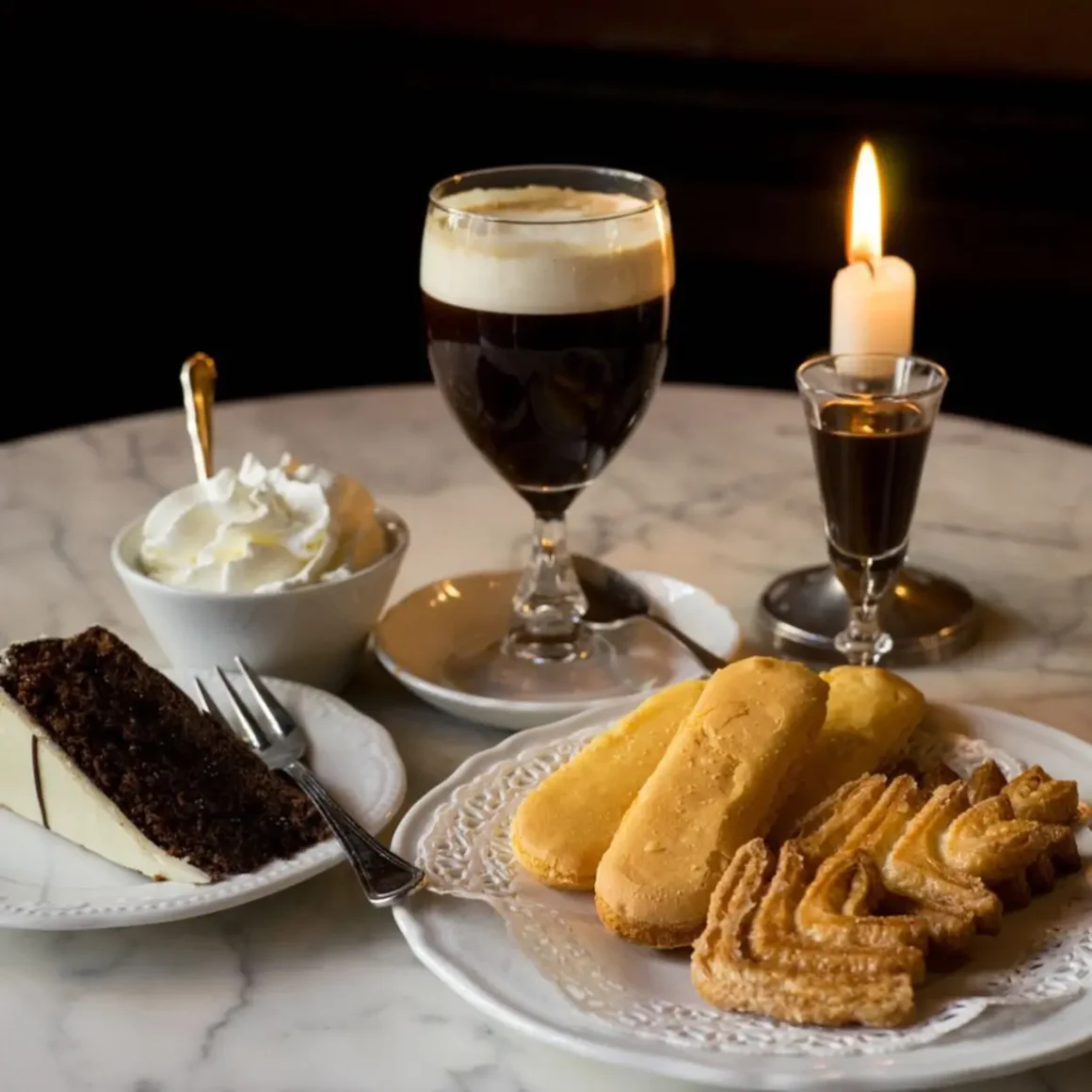
While Bicerin stands alone as a delightful beverage, its richness and flavor profile open the doors to a plethora of culinary pairings. Whether you’re looking to sweeten your palate, delve into the savory, or enhance your evening with a touch of spirits, there’s a perfect match for every Bicerin enthusiast.
Best Desserts to Pair with Bicerin
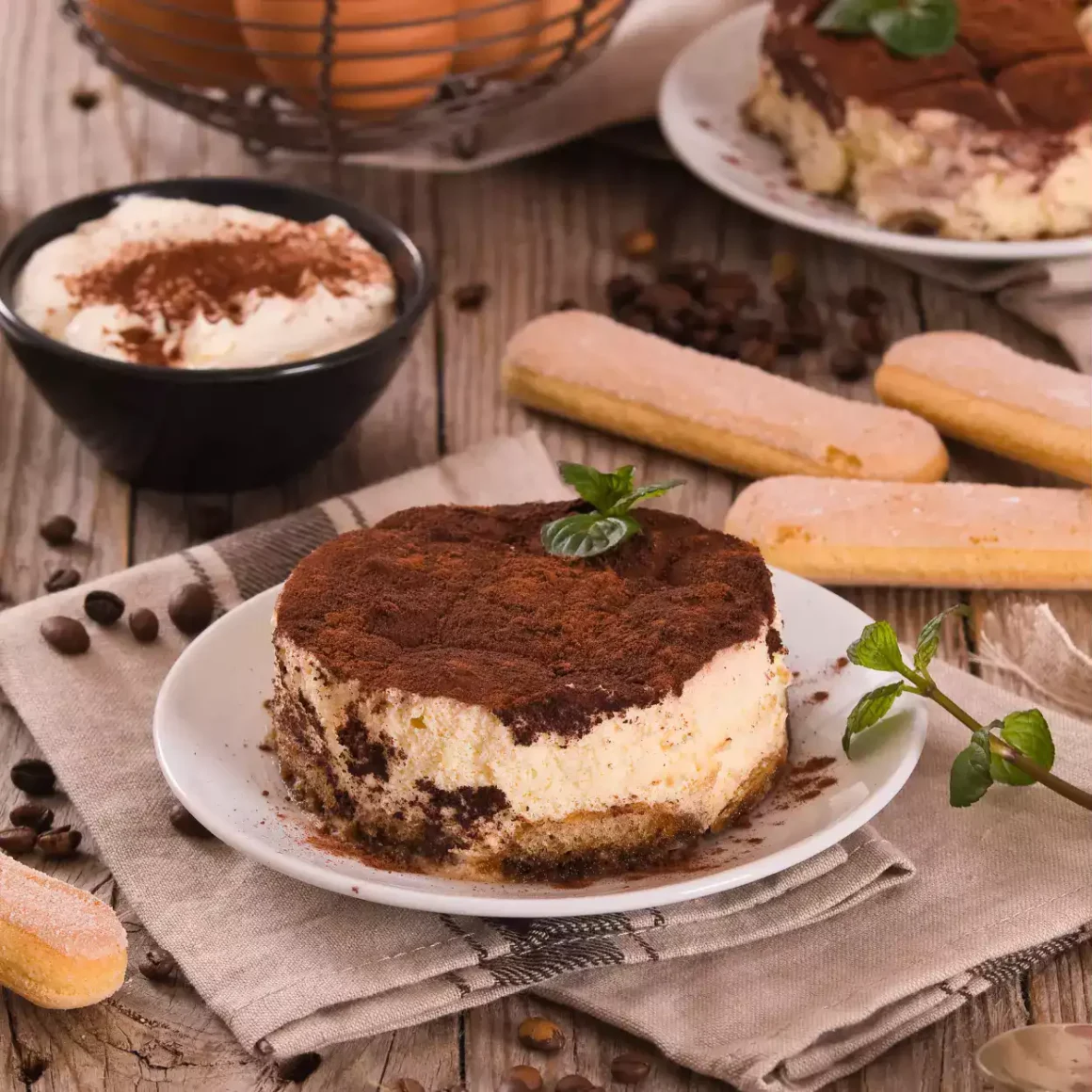
A glass of Bicerin, with its lush layers and rich taste, can be impeccably paired with desserts that either complement or contrast its flavors.
- Tiramisu: This classic Italian dessert, with its layers of mascarpone and coffee-soaked sponge, goes hand-in-hand with Bicerin, accentuating its coffee undertones.
- Hazelnut Biscotti: The crunchiness of biscotti complements the smoothness of Bicerin, and the subtle hazelnut flavors resonate with the nutty undertones of the drink.
- Panna Cotta: The creamy texture and mild taste of Panna Cotta serve as a calm backdrop, allowing the complex flavors of Bicerin to shine.
As you indulge in these delectable treats, you’ll find that each bite harmonizes with the notes of Bicerin, creating a symphony of flavors.
Savory Companions: From Breakfast to Dinner

Bicerin isn’t just a dessert beverage; its unique taste profile allows it to complement savory dishes as well.
- Breakfast Pastries: A flaky croissant or a buttery slice of brioche can be a wonderful morning companion to Bicerin, making your breakfast feel even more luxurious.
- Cheese Boards: Soft cheeses like Brie or Camembert, with their creamy textures, balance the rich chocolatey layers of Bicerin. Add in some nuts and dried fruits, and you’ve got a match made in heaven.
- Charcuterie: Believe it or not, the saltiness of prosciutto or salami can contrast beautifully with the sweet and bitter notes of Bicerin.
With these savory pairings, Bicerin transitions seamlessly from a morning treat to an evening delight.
Wines and Spirits: Enhancing the Bicerin Experience
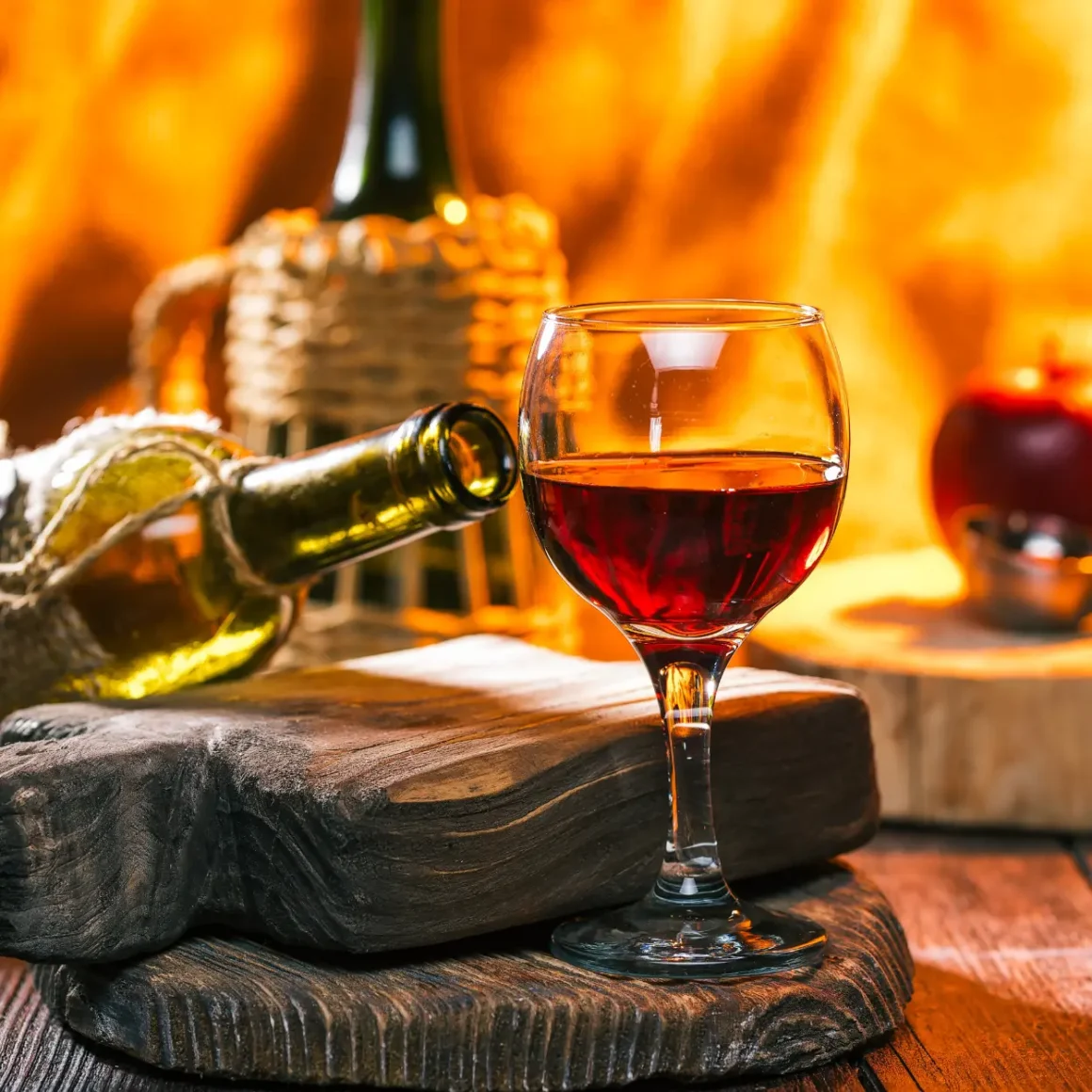
Elevate your Bicerin experience with a touch of wine or spirits, making your indulgence even more memorable.
- Bicerin Chocolate Liqueur: Add a splash of this to your traditional Bicerin for an intensified chocolate flavor and an alcoholic kick.
- Dessert Wines: Port or Sherry can provide a sweet counterbalance to Bicerin’s deep flavors.
- Bicerin Italian Chocolate Liqueur: Distinct from the former, this liqueur is a blend of coffee and chocolate, and when added to Bicerin, it amplifies its richness.
Pairing wines and spirits with Bicerin not only accentuates its character but also adds a layer of sophistication to your beverage experience.
Sustainability and Coffee: Bicerin’s Ethical Side
In today’s world, where conscientious consumption is more important than ever, Bicerin isn’t just a drink that pleases the palate—it’s also an experience that can be ethically gratifying. From ethical sourcing to eco-friendly practices and support for local businesses, Bicerin can be a model beverage for sustainability. Here, we explore the various ways in which you can enjoy Bicerin responsibly.
Ethical Sourcing: Ensuring a Fair Cup of Bicerin

Ethical sourcing is the cornerstone for ensuring that your Bicerin experience aligns with responsible consumption.
- Fair Trade Coffee: Opting for fair trade coffee beans guarantees that the farmers producing the coffee are paid fairly for their labor and produce.
- Local Dairy: Sourcing milk from local dairies that engage in humane animal practices is another step toward ethical Bicerin.
- Transparent Supply Chain: A clear understanding of where your chocolate comes from can ensure it’s sourced from farms that do not exploit labor or engage in unsustainable practices.
By taking the time to ensure each layer of your Bicerin is ethically sourced, you contribute to a more equitable global trade landscape.
Bicerin and Environment: Eco-friendly Practices
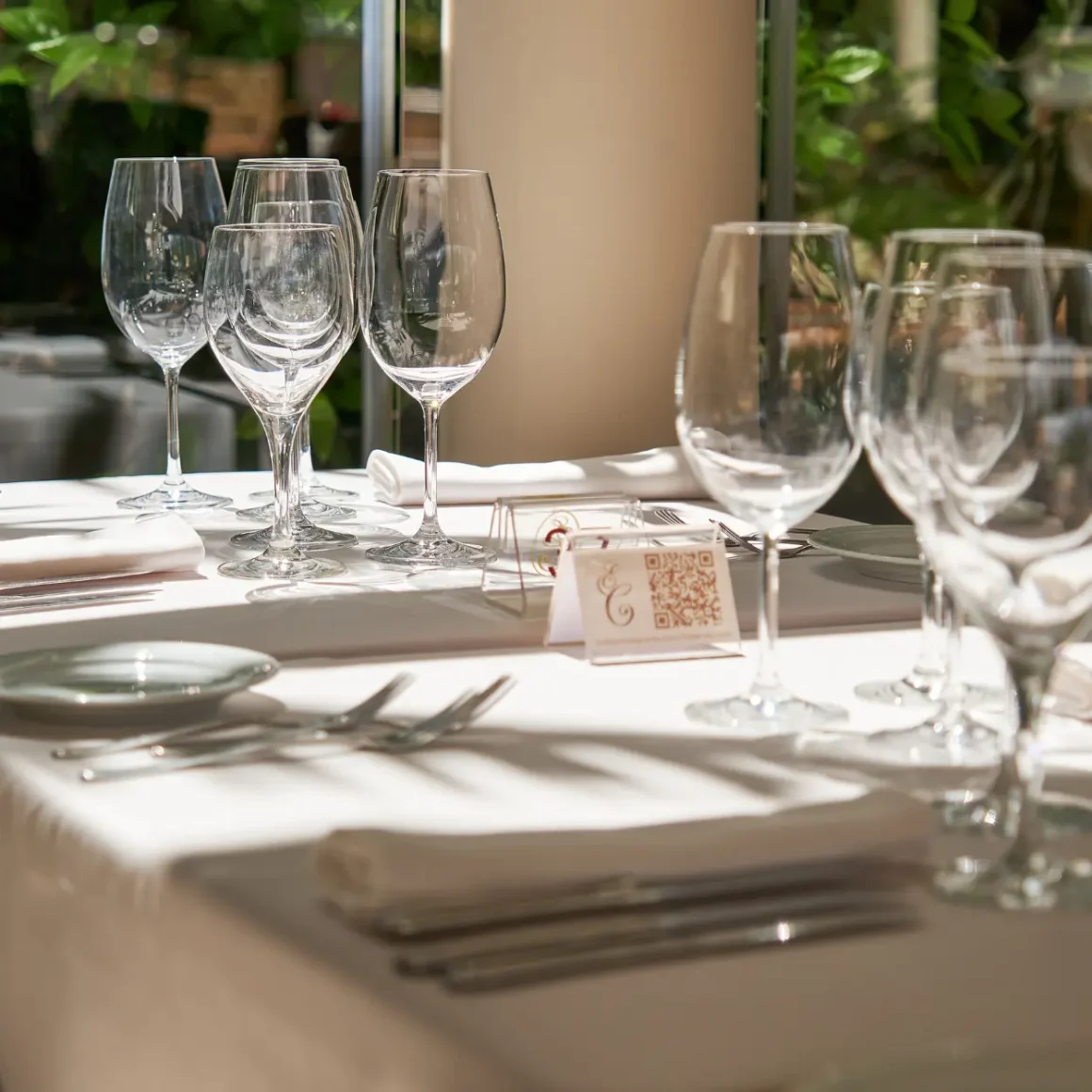
Sustainability isn’t just about where your ingredients come from—it’s also about how you use them and what happens afterwards.
- Reusable Glassware: Opt for reusable mugs and glasses to enjoy your Bicerin instead of single-use containers.
- Recycling and Composting: Be sure to recycle your glass and plastic containers and compost your coffee grounds.
- Energy-Efficient Brewing: Use energy-efficient coffee machines and espresso makers to prepare your Bicerin, thereby reducing your carbon footprint.
Making your Bicerin experience eco-friendly is a step toward combating climate change and conserving natural resources.
Supporting Local: Cafés Making a Difference
Consuming Bicerin can also be a local affair that sustains communities and promotes ethical entrepreneurship.
- Local Cafés: Support local cafés that are committed to ethical sourcing and eco-friendly practices. These establishments often also contribute to local charities and community development projects.
- Community-Based Suppliers: Cafés using ingredients from local farms and suppliers not only offer a fresher product but also contribute to the local economy.
- Social Programs: Some cafés go above and beyond by being involved in social programs, like training at-risk youth or employing people from marginalized communities.
By choosing to consume Bicerin at local cafés that make a positive impact, you contribute to a cycle of sustainability and community well-being.
The way you enjoy your Bicerin can extend far beyond its delightful taste; it can be an ethical choice that has a lasting impact on both human lives and the environment.
Conclusion
In wrapping up this exploration, we’ve journeyed through the rich tapestry that makes Bicerin coffee so much more than just a beverage. From mastering the recipe to savoring its ethical and sustainable aspects, Bicerin emerges as a multi-dimensional experience. Whether you’re pairing it with sumptuous desserts or exploring its notable history adorned by famous patrons and cultural significance, this Italian classic transcends the boundaries of a typical coffee drink. It is an emblem of ethical sourcing and community support, as well as a symbol of luxurious taste that has captivated attention across modern coffee trends and even pop culture. Ultimately, Bicerin is not just a coffee; it’s a story, a legacy, and a responsibly delightful indulgence.
FAQ
How does Bicerin differ from other layered coffee drinks?
Bicerin stands out due to its distinct layers of espresso, hot chocolate, and cream, which are not mixed but rather sipped in a unique sequence.
Which famous personalities have expressed their love for Bicerin?
Notable figures such as Alexandre Dumas Sr. and Friedrich Nietzsche have publicly praised Bicerin, and the drink has historical connections to Italian luminaries like Camillo Benso di Cavour.
Are there vegan or dairy-free versions of Bicerin?
Yes, you can make vegan or dairy-free Bicerin by using plant-based milk and cream alternatives like almond milk or coconut cream.
How has the Bicerin recipe evolved over the centuries?
While the core elements of espresso, chocolate, and cream have remained, modern twists and ethical sourcing practices have updated the traditional Bicerin recipe for contemporary tastes.
